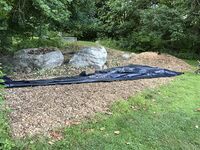Japanese Knotweed

Fallopia japonica, a.k.a Reynoutria japonica and Polygonum cuspidatum (GoBotany, Wikipedia, USDA -- NISIC) is a very invasive species, which is very difficult to remove due to its large, deep, underground network of rhizomes. It is a perennial which can regrow to 10 ft. in height each year. It has a thick, hollow stem, and a distinctive heart shaped leaf.
Removal
Removal is EXTREMELY difficult. The roots go very deep (up to ten feet), and spread horizontally. Any small piece of rhizome will sprout and regrow.
Regular cutting/mowing can slow down its growth, but will not kill it and is not recommended as it will encourage the plant to spread horizontally. Care should be taken that the mower doesn't spread the material.
The NH Dept. of Agriculture has a Japanese Knotweed Best Management Practices which recommends smothering it:
- Allow it to start growing, then cut it flush to the ground at the beginning of June.
- Allow the cut material to dry out.
- Cover the area (including the cut material) with 4 to 6" of wood chips. The area should extend to at least two feet outside of any knotweed plants.
- Cover these wood chips with thick black plastic. 7 mil thickness is recommended, but hardware stores only stock 6 mil thickness as their "heavy duty" black plastic. A two foot overlap between sheets is recommended.
- Cover the black plastic with 4" of wood chips, to protect it. Be very careful not to puncture the plastic.
- If you do puncture the plastic, knotweed will find it and grow out. Remove the wood chips from that area. Remove any plant material and dry the plastic. Patch the hole, using more black plastic duct-taped down. Note that just patching a puncture with duct tape usually doesn't work, as the knotweed will push the duct tape off of the plastic. You need a bigger surface (the patch) weighed down with wood chips to contain it.

An example of this smothering technique is along the north side of the Little Playing Field at Great Hill. Most of it was done in 2022, with a final portion being covered in 2023 (report).
Common Mis-Identifications
Eastern Redbud (Cercis Canadensis, Wikipedia, USDA - Factsheet) Redbud saplings have a similar leaf, and can even have a similar shape. Redbud is a woody plant, however, unlike the hollow stem of Japanese Knotweed. And Japanese Knotweed is rarely found growing as a single stalk.